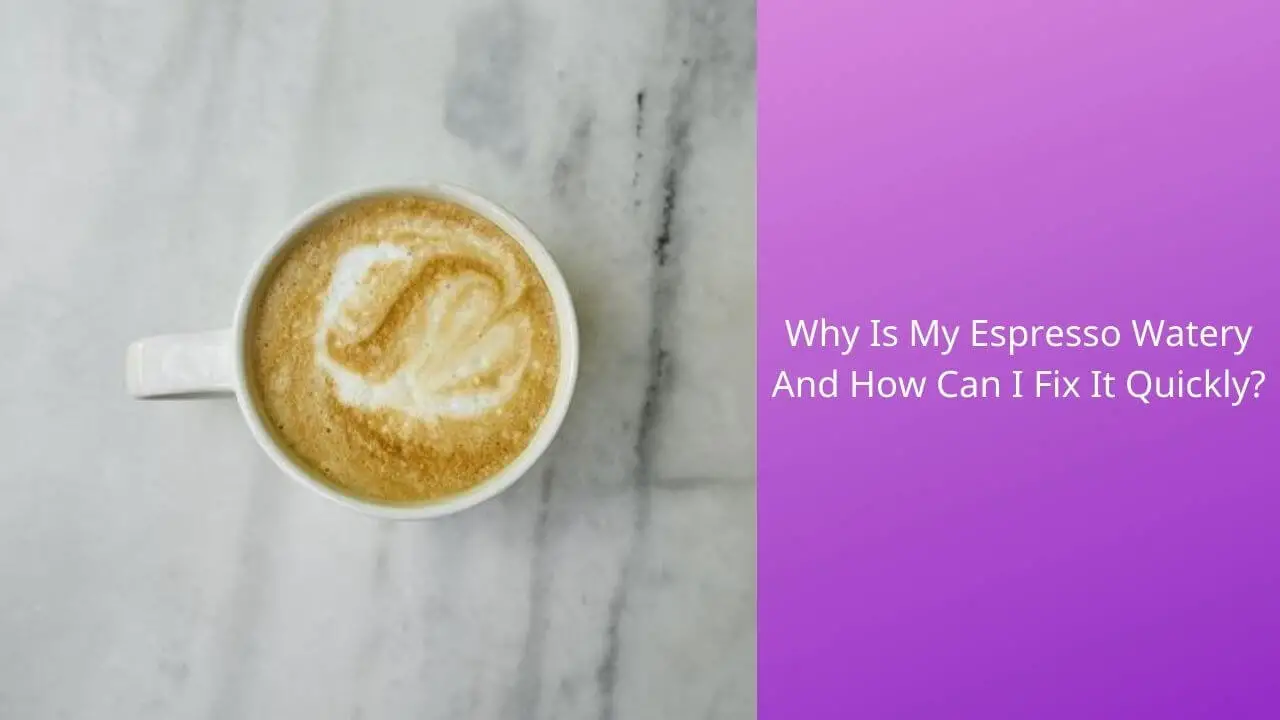Why is My Espresso Watery? Uncover Remarkable Solutions
Many people are passionate about achieving the perfect cup for espresso. However, sometimes it cannot be easy to get the right balance of flavor and crema. One common issue is that espresso can often come out watered down.
So, what can you do to fix this? In this blog post, we’ll explore some possible reasons why your espresso might be watery and offer some tips on how to improve it.
Why is My Espresso Watery? (The Most Common Reasons)

There are a few reasons why your espresso might be coming out watery. It could be that you’re using too much coffee or that your grind is too fine (check this article for grinding tips). It could also be that your machine isn’t extracting the coffee properly.
If you’re using too much coffee, the water-to-coffee ratio is off, resulting in a watery espresso. The fix is simple: use less coffee.
If your grind is too fine, the water will have difficulty flowing through the coffee and extracting all the flavors. The result will be a weak and watery espresso. To fix this, make sure to use a coarser grind next time.
If your machine isn’t extracting the coffee properly, it could be because the water temperature is too low or the pressure is too low. Both of these problems can be fixed by adjusting the settings on your espresso machine.
Why is My Espresso Machine Making Watery Espresso?

One of the most common causes is a fine-grind size. When the coffee grounds are too fine, the water can pass through them too quickly, resulting in a weak and watery espresso.
Another possible reason is incorrect tamping. Tamping refers to packing the coffee grounds into the espresso machine. If the coffee grounds are not filled tightly enough, the water will flow through them too rapidly, creating a watery shot.
Lastly, the espresso machine may require a thorough cleaning as accumulated coffee oils and residues can impact the flow and temperature of the water.
How Do You Fix Watery Espresso? (Some Useful Tips)

There are a few things you can do to fix this:
- Use a coarser grind: This will allow the water to flow more easily through the coffee grounds and extract all flavors.
- Increase the brewing time: This will give the water more time to extract all flavors from the coffee grounds.
- Use less coffee: This will make it easier for the water to extract all flavors from the coffee grounds.
If you find that your espresso is still watery after trying these tips, then it’s possible that your machine is not extracted properly. In this case, it’s either best to contact your machine’s manufacturer or invest in a new good espresso machine.
Frequently Asked Questions About Why Is My Espresso Watery
Can I add more coffee grounds to my espresso?
No, adding more coffee grounds will not make your espresso less watery. It will probably make the problem worse.
How do I know if I’m using the right amount of coffee grounds?
The general rule is to use about two tablespoons of coffee for every 6 ounces of water. You can use up to 3 tablespoons of coffee per 6 ounces of water if you make a large batch.
What is the ideal brewing time for espresso?
The ideal brewing time for a shot of espresso is typically between 20-30 seconds. If your machine is brewing faster than this, it could lead to a watery shot.
Does the grind size affect the consistency of my espresso?
Yes. A finer grind can slow down extraction time, leading to a thicker and richer espresso. Conversely, a coarse grind can speed up extraction time and produce a watery shot.
Can the quality of the water I use affect my espresso?
Yes, the quality of water can significantly influence the taste of your espresso.
What role does temperature play in brewing espresso?
A temperature that’s too high can result in a burnt taste, while a temperature that’s too low can make your espresso taste sour and under-extracted.
What is the significance of tamping in espresso brewing?
The right amount of pressure during tamping provides the correct resistance for the water passing through, which is vital for a well-extracted, non-watery shot of espresso.
Final Verdict
So, what’s the verdict? Is your espresso watery because of too much coffee, not enough tamp pressure or a bad grind? Hopefully, we’ve helped you diagnose the issue and give you some tips on why is my espresso watery and how to fix it.
Remember that practice makes perfect – so keep brewing and adjusting until you get that perfect cup of espresso just the way you like it. Do you have any other tips for fixing watery espresso? Please share them with us in the comments below. We love hearing from you.







